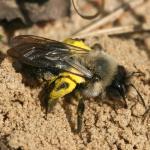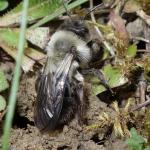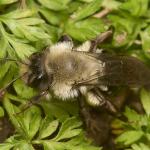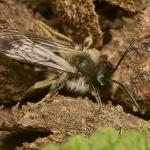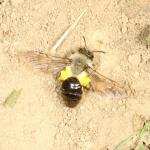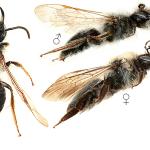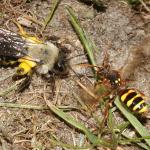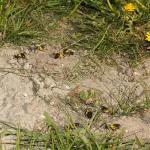Andrena pratensis MULLER 1776; Andrena ovina KLUG 1810; Andrena nitidiventris BLANCHARD 1850; Andrena atricula BISCHOFF 1922
This is a large, very distinctive bee with the thorax densely clad in snow-white hairs and the metasoma almost glabrous, with sparse black hairs and the integument entirely black and polished.
Records can be submitted online HERE
Identification notes are given below
This species is apparently a recent colonist to Britain. Until 2014 there were only a few old authenticated British records of the bee, all from south-east England. The earliest records are a male without locality, but considered to be British (Perkins, 1917b); Deal, East Kent, male, 12th April 1939 (Yarrow & Guichard, 1941) (BMNH); Bignor, West Sussex, female, 16th April, 1945 (Andrewes, 1946) (BMNH); Folkestone, East Kent, female with pollen load, 12th April, 1946 (Collins, 1946).
After a gap of sixty years during which no individuals were recorded in Britain, the species was encountered at Dungeness, East Kent, by R. Gomes in 2008, although at that time its identity was not established. He collected voucher specimens from the site on 18th March 2009 (both sexes) and these were identified by G.R. Else in 2014. On 20th April 2014 R. Tidman independently encountered it at the same site. The species was well established there with a nesting aggregation and pollen-laden females returning to their nest burrows (R. Gomes and R. Tidman, pers. comm.). In 2015 the species was locally common at the site with an estimate of 100 females active there in April that year (Early, 2015).
On 8th April 2014, a female was found at Brownwich Cliff, South Hants by G.R. Else, at rest on the cliff face, and he observed two further females there (one approaching its nest burrow with a full pollen load) on 14th April in the same year. The following year a male was found by him on 25th March in the same site, visiting a Salix catkin. A further male was found there in 2016.
I. Beavis (pers. comm.) recorded a female at Dunorlan Park, Tunbridge Wells, West Kent, on 6th April 2015. The bee was flying low over a sunny south-facing bank with short turf. A female was observed at Little Burton, Willesborough, East Kent, on 14th April 2015 by H. Silk.
The species was recorded for the first time in North Essex when a female was found at Cockaynes Wood Reserve west of Alresford, on the 15th April, 2016, by D. Scott.
The species is widely distributed in Eurasia from Scandinavia to France, east to Turkey, Caucasus, Kazakhstan and Kyrgyzstan (Kocourek, 1966; Osytshnjuk, 1977; Ascher & Pickering, 2012).
Listed in Shirt (1987) as Endangered (RDB1) and revised to “believed extinct” by Falk (1991). Recent colonisation means this status needs to be reviewed.
Andrena vaga is a black and greyish-white mining bee. This species could easily be overlooked as it is similar to the widespread A. cineraria (especially the males).
A. vaga is completely grey haired across the top of the thorax, whereas A. cineraria has an obvious black band across the middle of the thorax. See photos below.
Above: Andrena vaga female - photo R. Tidman
Above: Andrena cineraria female - photo J. Early
Generally open sites rich in willow (sallow).
Univoltine; from mid March to mid May.
Only two nesting aggregations have been found in Britain. One, extensive in 2015, is known from a partly vertical and partly sloping bank at Dungeness, East Kent (R. Gomes, pers. comm.). The other is a very small aggregation (only one known nest burrow though three females were observed nearby) on a sandy coastal cliff face in South Hants. Elsewhere in Europe this species generally nests in large aggregations in rather hard ground, amongst sparse vegetation on horizontal or sloping surfaces; the nest burrows are excavated vertically (Kocourek, 1966). Vleugel (1947) describes the nesting habits of this species in detail; his nesting aggregation was in a very steep slope. Extremely extensive nesting aggregations (including 10,000 nests in one site) occur along the Rhine, Germany (Bischoff, 2003; Fellendorf, Mohra & Paxton, 2004).
There is a single flower record for Britain, a male on Salix.
None are known for Britain. In mainland Europe Nomada lathburiana (Kirby) is a known cleptoparasite of this bee (Stöckhert, 1933, Vleugel, 1947; Kocourek, 1966). In northern Germany and Denmark the adult is attacked by Stylops muelleri Borchert and, in Denmark, possibly by S. krygeri Pierce (Kinzelbach, 1971).
2018


